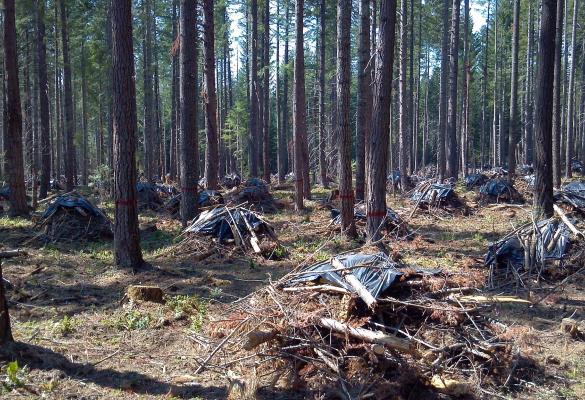Thinning
Forest thinning refers to removing trees in a forest stand to allow space for other trees and plants to grow (Punches 2004). Thinning is a silvicultural treatment used for commercial forest management and wildfire mitigation. Thinning projects are often performed as a part of larger forest land and resource management plans (USFS 2018). Mechanical thinning is the process of removing trees in overgrown forests to reduce the risks of extreme wildfires (Westover 2021). It is also frequently referred to as mechanical treatment, a more general term for any mechanized forest treatment, including mechanized cutting and hand thinning. Thinning can be done with chainsaws, crosscut saws, hand tools, bulldozers, and woodchippers (Westover 2021). As a nature-based solution, the primary goal of forest thinning is to reduce fuel and fuel connectivity to reduce high-intensity crown fires (Banerjee 2020). Thinning that is not followed by prescribed fire is not always an effective tool to combat wildfire spread, so it is essential to use them together as much as possible (Kittler 2022).

Case Studies
Apache- Sitgreaves National Forest and White Mountain Apache Tribe
Forest Fuel Treatment Efficacy in BC
Forest Mayordomos: A Collaborative Forest Management Strategy
Forest Thinning to Restore Fire Resilience at Lassen Volcanic National Park
Goats as a Tool for Fire Management on the Pueblo of Sandia
Modeling Forest Thinning Effects on Water Yield for the Four Forest Restoration Initiative
Prescribed Underburning in Southwest Oregon
Remote Sensing to Quantify Woodland Canopy Cover on the San Carlos Apache Reservation
Saint Vrain Forest Health Partnership Project
Velvet Mesquite Thinning to Improve Riparian Forests along the San Pedro River
Wood for Life, a Collaborative Partnership to Provide Wood to the Navajo Nation and the Hopi Tribe
Tools
A Land Manager's Guide for Creating Fire-Resistant Forests
Climate Adaptation Actions for Urban Forests and Human Health
Community Wildfire Mitigation Pocket Guide
Forest Vegetation Simulator (FVS)
Guidelines for Thinning Ponderosa Pine for Improved Forest Health and Fire Prevention
Mitigation Action Portfolio (MAP)
National Priorities for Broad-Scale Fuels Management
Promoting Nature-Based Hazard Mitigation Through FEMA Mitigation Grants
The Fire and Fuels Extension to the Forest Vegetation Simulator: Updted Model Documentation
WEBPAGE - Innovations in Biochar (Published: October 2019)
Likely Benefits and Outcomes
This strategy is likely to achieve these project goals. Click to search for strategies with a similar benefit.
Related Green (natured-based) vs. Gray infrastructure
In development.
